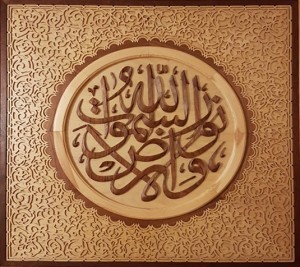
Wood arts are art forms that were shaped by art movements in many different cultures throughout the ages, used in a variety of areas from common daily objects to functional constructions. Starting with the Turks in Central Asia in terms of traditional Turkish arts; they were developed through the sense of art of the Seljuks, Anatolian Beyliks (small principalities) and the Ottoman Empire. Many construction and decoration materials used in religious and civil architecture can be found among the wooden samples that have survived to date. These mainly consist of minbars, lecterns, rahlas (small reading desks), Qur’an cases, railings, window-door wings, eaves, ceilings joists, columns, column heads, ceiling roses, frames, kavukluks (shelves for holding turbans), lamp stands, folding screens, coffee tables, boxes, cases, and the like.
Though the wood types that are used in wood works vary, the most common ones in terms of durability and ease of working are ebony, oak, walnut, apple, pear, boxwood, cedar, linden and rose. The patterns and motifs that are used in wood art samples are of remarkable richness. While a more compiling expression is observable in the first stages of the Islamic Art; a new synthesis can be seen that arose from the fusion of the local decoration sources with the techniques and styles brought to Anatolia by the Turks. Wooden decorations are characterized by herbal, geometric, scripture (khatt) and, if slightly, figure depictions. Wood artists in the Ottoman Empire were called “neccar”.
In wood art, both decorative designs created with patterns and decorations created with various techniques are commonly used. In the Ottoman era, wood carving method called “naht” was the most commonly used technique. It is implemented by cutting and carving the parts between the patterns drawn on wood. It has various different types such as low relief, high relief, deep carving, inclined cutting, reticulate carving, cage carving, decoupage. Inlaying is another one of the methods used in wood decoration where different carving techniques are used on the same surface. In this technique also known as “Tarsi”; mother-of-pearl, ivory, bone, tortoise shell, ebony or gold-silver wires are embedded in the holes carved on the wood according to the drawn pattern. It is possible to encounter various types and colors of wood used in inlaying works. Painting on wood is often seen in consoles, beams, and columns of mosques and ceiling roses of houses. Herbal motifs and colors like blue, yellow, red are commonly used. Wood burning should also be mentioned among the wood decoration techniques. It is applied on wood by creating dark colored areas by burning the surface of the wood or tracking the patterns with a heated iron pen.
The objects produced with the lacquering technique in the 17th and 18th century Ottoman wood working are called Edirnekârî (Edirne work), since they are especially common in Edirne. Edirnekârî is a painting and coloring art. It is often seen in ceilings, doors, closets, chests and drawers. Edirnekârî, which can also be applied on cardboard and leather other than wood, is a very difficult and painstaking technique. At first, the burrs on the work material are removed. Then, for the surface to soak in the paint, a layer of varnish is applied. After the varnish is dried, the herbal designs are implemented by using paint and gold. And after the paints are dried, layers of lacquer are applied, waiting for it to dry in between the applications.
The earliest examples of it are kündekârî works seen in 12th century Egypt, Aleppo and Anatolia. Kündekârî technique means interlacing small sized geometrical pieces without gluing or pounding, just by using grooves. In Kündekâri, which is a technique of fitting; polygonal, diamond and star shaped wood pieces with arabesque style relief carved insides are interlaced with wooden beams which connect these pieces together. Nails or glue are not used to connect these pieces together. Since the pieces are spliced, the wood does not crack or separate into blocks due to drying and shrinking with time.
Durable wood types such as apple, pear, walnut, boxwood are used in kündekârî. Sometimes a frame or a hoop is attached to the back surface in order to enhance the durability. Kündekârî is applied to areas like minbar mirrors, doors, window wings and lecterns. Since it is a technique that requires strength and care, it is possible to come across works that are made to look like kündekârî with methods like relief, gluing, carving rather than fitting-splicing. These kinds of works are called “imitation/fake kündekârî”.
Nowadays, the technique is continued through master-apprentice relationship by using traditional methods and materials.




